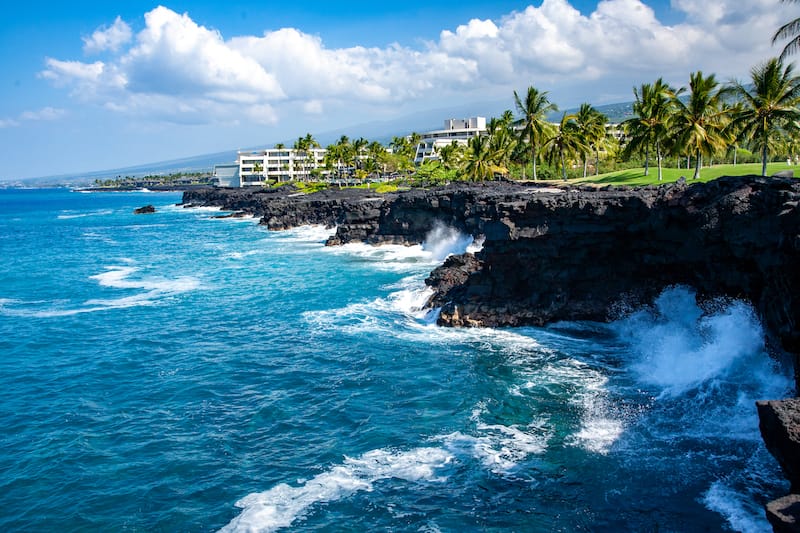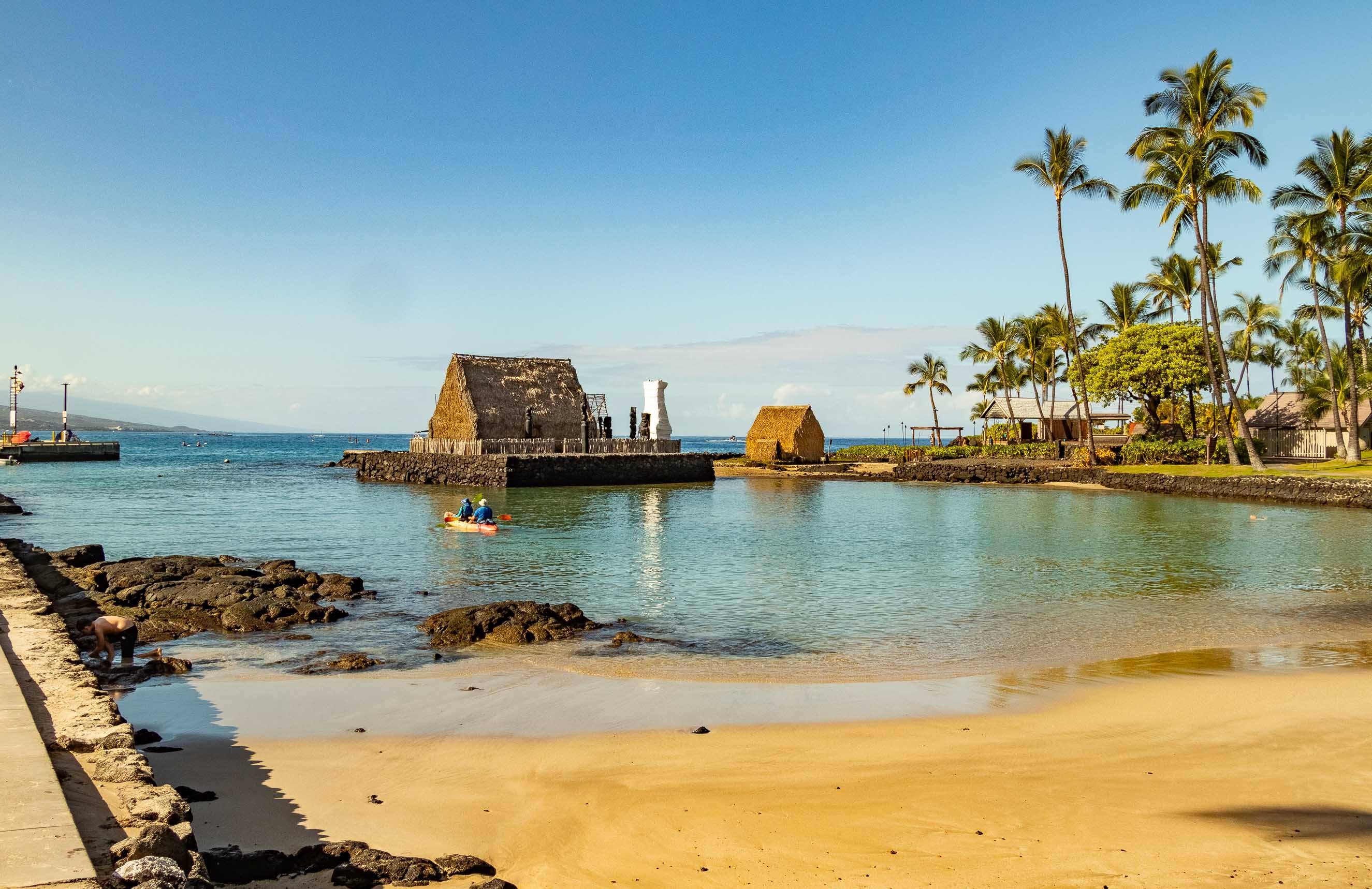Kona Coffee: Kona Hawaii

Nestled amidst the lush volcanic slopes of the Big Island of Hawaii, Kona coffee is a legendary brew that embodies the spirit of the islands. With its rich history, meticulous cultivation, and distinctive flavor profile, Kona coffee is a true treasure of Hawaii, captivating coffee enthusiasts worldwide.
History and Origin, Kona hawaii
Kona coffee’s journey began in the late 1800s when Arabica coffee beans were introduced to the region. The unique volcanic soil, abundant rainfall, and ideal microclimate of the Kona district created an exceptional environment for coffee cultivation. The region’s distinctive terroir, coupled with the dedication of local farmers, gave rise to a coffee renowned for its exceptional quality.
The Kona Coffee-Growing Process
Kona coffee cultivation is a labor of love, involving meticulous attention to detail from bean to cup.
- Planting and Growing: Coffee plants are carefully nurtured in shaded nurseries before being transplanted to the slopes of Mauna Loa and Hualalai volcanoes. The rich volcanic soil and moderate temperatures provide the ideal conditions for growth.
- Harvesting: The coffee cherries are hand-picked at their peak ripeness, ensuring optimal flavor and quality. This meticulous process is essential to maintain the high standards of Kona coffee.
- Processing: After harvesting, the coffee cherries undergo a rigorous processing method, which includes pulping, fermentation, washing, and drying. This meticulous process ensures that the beans develop their unique characteristics and flavor profiles.
- Roasting: Kona coffee beans are roasted to perfection, bringing out their distinctive flavor notes. Roasting is an art form, and skilled roasters carefully control the temperature and time to achieve the desired flavor profile.
- Brewing: Kona coffee is best brewed using a pour-over method or a French press, allowing the coffee’s delicate flavors to fully develop.
Kona Coffee Varieties
Kona coffee is known for its diverse range of varieties, each with its own unique flavor profile.
- Typica: This variety is known for its delicate acidity and floral aromas, often with notes of chocolate and citrus.
- Bourbon: Bourbon beans produce a smooth and balanced cup with hints of caramel and nuts.
- Caturra: This variety is characterized by its bright acidity and bold flavor, often with notes of berries and spices.
Brewing Tips
To enjoy the full potential of Kona coffee, consider these brewing tips:
- Freshly Roasted Beans: Use freshly roasted Kona coffee beans for the best flavor.
- Proper Grind: Grind the beans to a medium-fine consistency for optimal extraction.
- Water Temperature: Use filtered water heated to 200-205°F for optimal flavor extraction.
- Brewing Method: Experiment with different brewing methods to find your preferred flavor profile.
Kona Coffee Farms and Tasting Experiences
If you’re visiting the Big Island, be sure to visit some of the renowned Kona coffee farms and tasting experiences:
- Kona Coffee Belt: Explore the scenic Kona Coffee Belt, dotted with numerous farms offering tours and tastings.
- Holualoa Coffee Mill: This historic mill offers tours and tastings, showcasing the coffee-making process from bean to cup.
- Greenwell Farms: This sustainable coffee farm offers tours, tastings, and a unique opportunity to learn about their eco-friendly practices.
Exploring Kona’s Natural Wonders

Kona, on the Big Island of Hawaii, is a paradise of volcanic landscapes, lush rainforests, and stunning coastlines. The island’s unique geological history and diverse ecosystems offer a wealth of natural wonders to explore.
Volcanic Landscapes
Kona’s volcanic origins are evident in its dramatic landscapes. The island is formed by five shield volcanoes, including Mauna Loa, the world’s largest active volcano. The volcanic activity has created a diverse range of features, from lava flows and cinder cones to volcanic craters and calderas. These volcanic landscapes are not only visually striking but also play a crucial role in Kona’s ecology and culture.
Lush Rainforests
On the windward side of Kona, where rainfall is abundant, lush rainforests thrive. These forests are home to a diverse array of flora and fauna, including endemic plants and endangered species. The high rainfall and rich volcanic soil support a vibrant ecosystem, creating a green oasis in the midst of the arid volcanic landscape.
Stunning Coastlines
Kona boasts a stunning coastline, featuring black sand beaches, turquoise waters, and dramatic cliffs. The volcanic activity has shaped the coastline, creating unique geological formations and diverse marine ecosystems. The coast is a popular destination for swimming, snorkeling, diving, and whale watching.
Flora and Fauna
Kona’s diverse ecosystems support a wide range of flora and fauna. The island is home to numerous endemic plants, including the Hawaiian hibiscus, the ʻōhiʻa lehua tree, and the ʻōhiʻa ʻāhiʻa tree. The rainforests are home to a variety of endangered species, including the Hawaiian monk seal, the Hawaiian goose, and the ʻākepa.
Hiking Trails and Scenic Drives
Kona offers numerous hiking trails and scenic drives that allow visitors to experience the island’s natural beauty firsthand. The Kealakekua Bay Trail offers stunning views of the coastline, while the Puʻuhonua o Honaunau National Historical Park features ancient Hawaiian temples and petroglyphs. The scenic drive along the Mamalahoa Highway provides breathtaking views of the volcanic landscape.
Cultural Significance
The volcanic landscape of Kona holds immense cultural significance for the native Hawaiians. The volcanic activity is seen as a manifestation of the goddess Pele, the Hawaiian goddess of fire and volcanoes. Many of the volcanic features are associated with Hawaiian myths and legends, adding a layer of cultural depth to the natural beauty of the island.
Top 5 Must-See Natural Attractions
| Attraction | Description | Image |
|---|---|---|
| Kealakekua Bay | A picturesque bay known for its clear waters and stunning views. It is also the site of Captain Cook’s first landing in Hawaii. | [Image of Kealakekua Bay with its clear waters and stunning views.] |
| Puʻuhonua o Honaunau National Historical Park | A historic park featuring ancient Hawaiian temples, petroglyphs, and a place of refuge for those who broke the kapu (ancient Hawaiian law). | [Image of Puʻuhonua o Honaunau National Historical Park with its ancient Hawaiian temples and petroglyphs.] |
| Mauna Loa Observatory | A world-renowned observatory located on the summit of Mauna Loa, offering breathtaking views and insights into volcanic activity. | [Image of Mauna Loa Observatory on the summit of Mauna Loa, with breathtaking views and insights into volcanic activity.] |
| Hawaii Volcanoes National Park | A park encompassing the active volcanoes Kilauea and Mauna Loa, offering a glimpse into the power and beauty of volcanic activity. | [Image of Hawaii Volcanoes National Park with its active volcanoes Kilauea and Mauna Loa.] |
| Punaluʻu Black Sand Beach | A unique black sand beach formed by volcanic activity, offering a stark contrast to the typical white sand beaches. | [Image of Punaluʻu Black Sand Beach with its black sand and volcanic origins.] |
Kona Culture and History

Kona’s rich tapestry of culture and history is woven from the threads of its Polynesian heritage, the transformative impact of coffee cultivation, and the vibrant traditions that continue to shape the community today. From its early settlers to its modern-day residents, Kona’s story is one of resilience, adaptation, and a deep connection to the land.
The Arrival of the Polynesians
The story of Kona begins with the arrival of the first Polynesian settlers, who voyaged across the vast Pacific Ocean in canoes, guided by the stars and their knowledge of the currents. These intrepid explorers landed on the shores of the Big Island, drawn by its fertile land and abundant resources. They established a thriving society, rooted in a deep reverence for the natural world and a strong sense of community.
The Influence of Coffee Cultivation
Coffee cultivation arrived in Kona in the late 19th century, transforming the region’s economy and social landscape. The introduction of coffee plantations brought about significant changes, including the development of infrastructure, the influx of new residents, and the rise of a distinct coffee culture. Kona coffee, renowned for its unique flavor and aroma, quickly gained international recognition, becoming a vital source of income for the region and shaping its cultural identity.
Traditional Hawaiian Arts and Crafts
Kona’s cultural heritage is evident in the traditional Hawaiian arts and crafts practiced by its people. Weaving, carving, and music are integral parts of Kona’s cultural expression, passed down through generations.
Weaving
Weaving, a traditional art form, is a testament to the skill and creativity of Kona’s artisans. Using natural fibers such as hala, olona, and i’e, they create intricate mats, baskets, and clothing. Weaving is not just a craft; it’s a way of life, reflecting the interconnectedness of people and nature.
Carving
Carving, another prominent art form, involves the skillful use of tools to create intricate designs and sculptures from wood, bone, and stone. From traditional tiki figures to contemporary pieces, Kona’s carvers continue to honor the ancient art of carving, preserving and transmitting their knowledge to future generations.
Music
Hawaiian music, with its soulful melodies and rhythmic beats, is an essential part of Kona’s cultural identity. The ukulele, a small guitar-like instrument, is a beloved symbol of Hawaiian music. Traditional chants, songs, and dances are performed at festivals, gatherings, and cultural events, keeping the spirit of Hawaiian music alive.
Historical Landmarks and Museums
Kona is home to a number of historical landmarks and museums that offer insights into its rich past.
Pu’uhonua o Honaunau National Historical Park
Pu’uhonua o Honaunau National Historical Park is a significant historical site, offering a glimpse into ancient Hawaiian culture. It served as a place of refuge for those who broke the kapu (ancient Hawaiian laws). The park features ancient temples, petroglyphs, and archaeological sites, providing visitors with a unique opportunity to explore the past.
Keauhou Shopping Center
Keauhou Shopping Center, a popular tourist destination, showcases the history of the Kona area. It features historical exhibits, cultural demonstrations, and a variety of shops and restaurants.
Timeline of Key Events
A timeline of key events in Kona’s history provides a deeper understanding of its cultural and social evolution:
- 1st Century AD: Arrival of the first Polynesian settlers on the Big Island.
- 18th Century: Captain James Cook arrives in Kona and establishes contact with the Hawaiian people.
- 19th Century: Introduction of coffee cultivation, transforming Kona’s economy and social landscape.
- 20th Century: Growth of tourism and the development of infrastructure.
- 21st Century: Continued focus on sustainable tourism, cultural preservation, and the promotion of Kona’s unique identity.
Kona hawaii – Kona, Hawaii, offers a unique blend of volcanic landscapes, vibrant culture, and world-class coffee. Planning a trip to this tropical paradise? Consider using google flighta to find the best deals on flights to Kona International Airport (KOA). Once you arrive, be sure to explore the historic Kailua-Kona town, witness the stunning sunsets over the Pacific, and savor the rich flavors of Kona coffee.
Kona, Hawaii, known for its rich coffee plantations and stunning sunsets, offers a tranquil escape from the hustle and bustle of everyday life. For a taste of Maui’s vibrant heart, a short flight away lies Kahului, Hawaii , a bustling hub with a charming blend of history and modern amenities.
While Kona captivates with its serene beauty, Kahului offers a taste of the dynamic energy that defines the islands.
